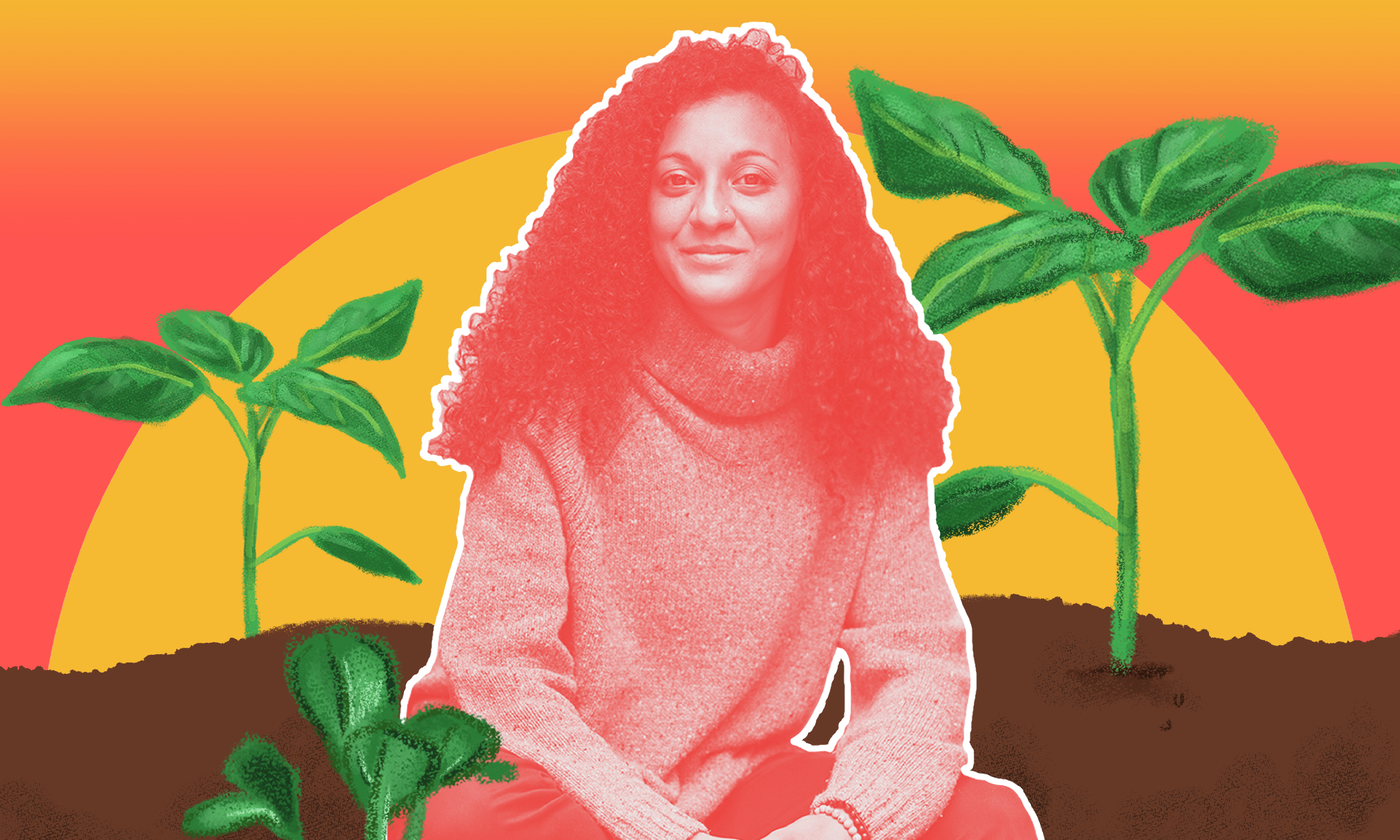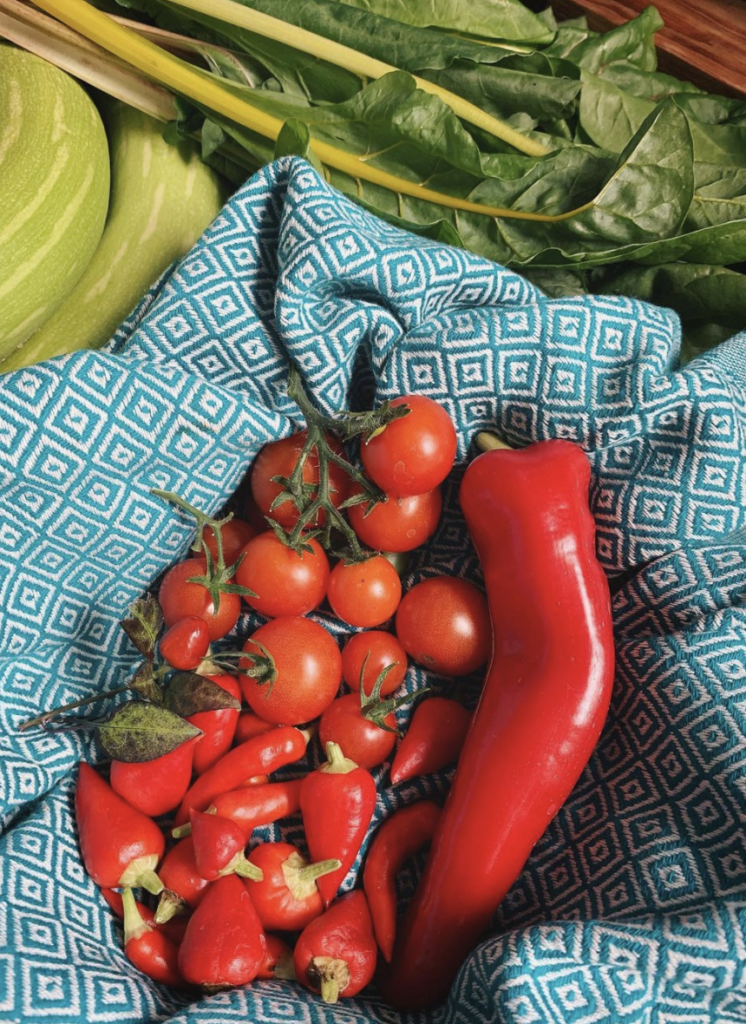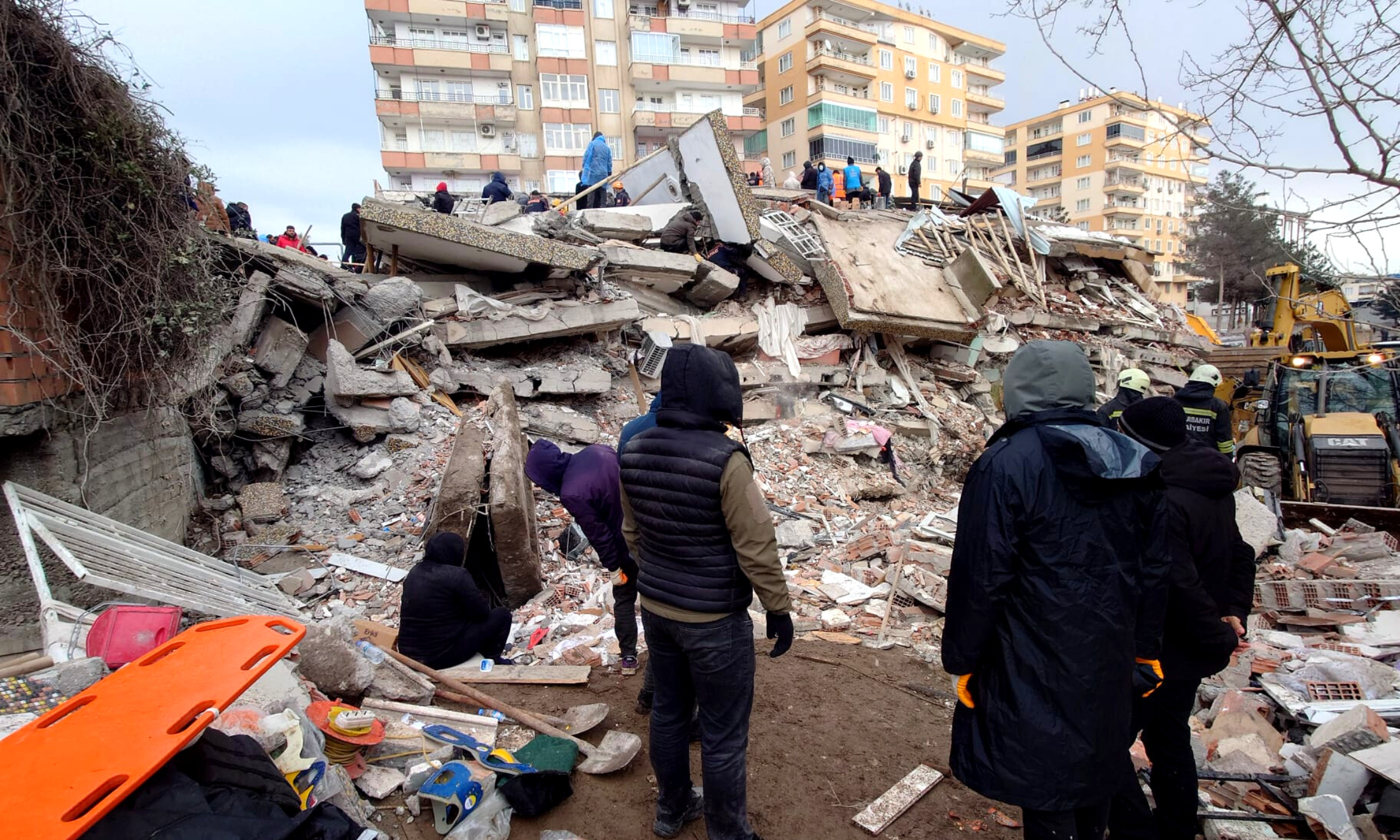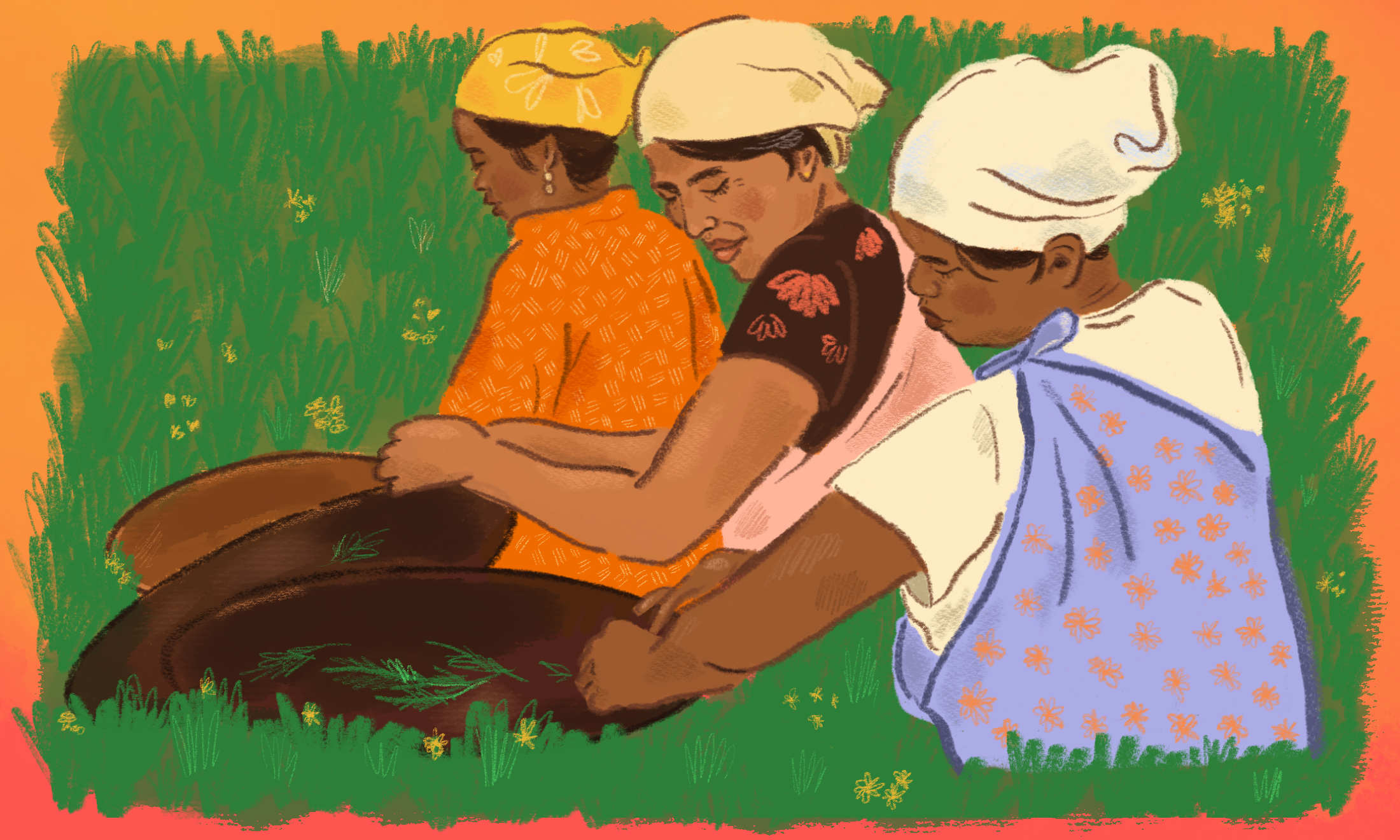Stuffed: how to grow callaloo with Claire Ratinon
The documentary producer turned organic food grower shares how she started out in horticulture – and what you can do to get stuck in and grow your own food.
Aimée Grant Cumberbatch
23 Jul 2021

photography by Andrew Montgomery / graphics by Javie Huxley
Claire Ratinon says she doesn’t have a good ‘how I got into gardening’ story. But I’m not so sure. Unlike other gardeners and green-fingered enthusiasts who trace the roots of their interest back to growing things with grandparents, the organic food grower and writer explains she was more interested in being inside with a book as a kid than outdoors with plants. Fast forward to leaving the UK and her time in New York working as a documentary producer and things changed. She happened upon a sign inviting passers-by to explore a rooftop growing space. Incredulous and intrigued, she did.
“I went up these stairs and all the way to the eighth floor. It’s amazing, there’s just over an acre’s worth of productive land on a rooftop in Queens, overlooking the Manhattan skyline… and it’s full of vegetables. I was so taken by this implausible space,” she explains. Other gardens had never captured her attention the way Brooklyn Grange – a collection of rooftop farms across the city – did. “It was like a light switched on.”
“We eat three times a day. We rely on these processes in order to, not just thrive, but be alive. [Food-growing] is the most amazing thing but it’s magicked away from our view. And the stuff that was growing was so vibrant and delicious, I couldn’t get enough of it,” she adds.
After Claire spent two summers volunteering at Brooklyn Grange, she decided she needed to make growing “a meaningful part of [her] life.” She returned home to London, eventually settling in a flat without even a windowsill to nurture seedlings on, and “ran around Hackney trying to find places that would let [her] near their plants.”
Slowly, she retrained alongside her production work and now horticulture is her full-time job. She has her own garden in the countryside in East Sussex and shares her knowledge with others in talks and workshops, as well as her 2020 book, How To Grow Your Dinner. So what would she recommend to those just starting growing?
“You’re not creating a sterile environment that just produces something and you take it. It’s about creating an ecosystem”
Claire Ratinon
“Always observe and take notes. Then you can figure out where you insert yourself in the process and where you can step back. It enables you to tune into the natural fluctuations of the outside world. Even when I’m not growing, I write down what the weather’s like every day.”
In her work, she emphasises gardening as something to participate in rather than take over and control. “You’re not creating a sterile environment that just produces something and you take it. It’s about creating an ecosystem. My garden is not just for me, [so] I’m very grateful, even when I’m cursing the flea beetle [that] has obliterated my pak choi.”
Claire links the unwillingness to let go and embrace change reflected in the formal gardens of traditional horticulture to colonialism, an idea she explores in a pamphlet created with her partner, artist Sam Ayre, entitled Horticultural Appropriation. “It touches not just [on] the actual physical role of colonialism within horticulture, but the echoes of that in the way that we grow. We are in a time of profound change – not just as in ‘let’s talk about colonialism’, but also climate change, the pandemic. We have to figure out how to be adaptive within something that has arguably kind of ossified around a very old style of doing things. [The pamphlet] presents different ways of assessing the possibilities.”
Below, Claire shares her tips for growing the ingredients that make up the classic Caribbean callaloo, a vegetarian dish, with the main ingredient being the leafy green of the same name, cooked with other vegetables and herbs. For an easy-to-follow recipe try this one from Eat Jamaican – just don’t @ me if it’s not as good as your Gran Gran’s! You can find a recipe for the similar Mauritian dish toufé bred from Cook Pad user Veenasa (no tomatoes and thyme needed).
Callaloo
Claire describes the vegetable callaloo as “pretty straightforward” to grow. She advises germinating its “very tiny seeds” somewhere warm — on a sunny windowsill or outside “when the weather’s warmed up.” Once your seedlings are ready to plant out (Claire recommends waiting for a consistent temperature of around 13C) space them at a distance of 30 cm – although if you’ve sowed directly into soil, thin out to this distance. Callaloo requires full sun and well-draining soil, to the point where it’s very drought tolerant. Always a bonus!
You can start harvesting as soon as it starts producing a number of leaves, Claire tells me. Don’t panic if flowers appear, as these can be removed “to encourage more leaf production”. She also recommends doing this if you don’t want growing callaloo “forever”, as the plant self-seeds very easily.
There’s no reason why you couldn’t try growing callaloo in a pot either, says Claire, but she recommends picking the leaves early to keep the plant small.
Tomatoes
Warmth is key to getting these going, as Claire explains in How To Grow Your Own Dinner: “Tomato seeds must be kept at around 20C to germinate, so it’s worth using a heated propagator if you start early.” She recommends potting your seedlings into increasingly bigger pots until they are 15 cm tall ‘when they can be moved to their forever home’.”
A sunny spot is non-negotiable for tomatoes, Claire writes that they’ll need at least eight hours a day. Feeding is almost as important, especially if growing in containers. She recommends incorporating seaweed meal into your compost before potting out and when flowers appear, feeding with liquid seaweed fertiliser every couple of weeks. As for watering, timing is crucial — Claire says “tomato plants prefer a big drink once or twice a week over a light sprinkling every day.”
If you’re planning on growing in pots, Claire advises using determinate or bush tomatoes, which are more compact. And if you’re really pushed for space, dwarf varieties “can thrive in surprisingly modest containers.”
Onion and garlic
Onion and garlic are fairly easy to grow and have similar needs. Even better, they will grow in containers. Claire suggests beginning them from sets in autumn and overwintering them in situ, but if you don’t have the space, you can start them off in spring.“Sow them 20cm apart, with each clove [or baby onion] pushed about 2cm into the ground, pointy end up.”
She explains that both crops will want somewhere sunny and soil full of nutrients, so enrich what’s already in the ground or “grow it in some really good multipurpose compost” in a pot. Onions and garlic are prone to rotting, so drainage is key. Overall, she says “keep it weed-free and moist without being soggy.”
Harvesting should take place “once the leaves turn yellow.” All you need is to “gently lift them out of the ground with a fork and leave them to dry.”
Chilli
The most important thing for chillies is giving them enough time to develop flowers and fruit. Claire tells me: “I sowed my seeds in late February. If you’re growing an early variety, you can sow them a bit later because they’re quicker to reach a yield.”
They need to germinate somewhere warm — Claire suggests an airing cupboard or a propagator, but says “once they get going, as long as they’ve got enough light they’re comfortable on a windowsill.” She advises against trying to grow them fully outside and instead says stick to “a conservatory, a windowsill, or in a greenhouse.”
Chillies need to be pollinated in order to bear fruit, so Claire recommends taking them outside when it’s warm to allow bees or the breeze to do their work. If you don’t have access to outdoor space, you can help out by giving the plants a little shake.
Thyme
When growing thyme, you should keep its natural habitat, the Mediterranean, in mind, says Claire. “If you think about what that climate’s like, it’s hot, dry and very well-drained. [Thyme] does not like having wet feet. You want it in a sunny space.” Luckily this means it thrives in pots where “you can control or at least have some say in how wet it gets.”
Whether you’re growing in the ground or in a container, you should “incorporate some grit or gravel to make sure that there’s additional drainage”. In terms of getting the plant going, Claire advises that it’s simple enough to start thyme from seeds or create a new plant from cuttings, but that buying a plant and nurturing it is the easiest route to a bountiful harvest.










